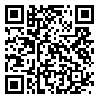1. Mohagheghi H, Kharghani P. The effect of schema therapy on anxiety, depression, and early maladaptive schemas in individuals with substance use disorder. Research on Addiction. 2021;15(60):299–324. [Persian] [
DOI]
2. Pournaghash Tehrani SS, Malekahmad M, Gholamali Lavasani M. Assessment of cognitive emotional dementions of personality and compaparison of psychological of prfile of individual with methamphetamine induce psychosis with normal subjects. Journal Of Psychological Science. 2021;20(100):533–6. [Persian] [
Article]
3. Weinberg A, Kotov R, Proudfit GH. Neural indicators of error processing in generalized anxiety disorder, obsessive-compulsive disorder, and major depressive disorder. J Abnorm Psychol. 2015;124(1):172–85. [
DOI]
4. Boothby CA, Kim HS, Romanow NK, Hodgins DC, McGrath DS. Assessing the role of impulsivity in smoking & non-smoking disordered gamblers. Addict Behav. 2017;70:35–41. [
DOI]
5. Baruch DE, Kanter JW, Busch AM, Juskiewicz KL. Enhancing the therapy relationship in acceptance and commitment therapy for psychotic symptoms. Clinical Case Studies. 2009;8(3):241–57. [
DOI]
6. Viskovich S, Pakenham KI. Randomized controlled trial of a web‐based acceptance and commitment therapy (ACT) program to promote mental health in university students. J Clin Psychol. 2020;76(6):929–51. [
DOI]
7. McClure JB, Bricker J, Mull K, Heffner JL. Comparative effectiveness of group-delivered acceptance and commitment therapy versus cognitive behavioral therapy for smoking cessation: a randomized controlled trial. Nicotine Tob Res. 2020;22(3):354–62. [
DOI]
8. Sloshower J, Guss J, Krause R, Wallace RM, Williams MT, Reed S, et al. Psilocybin-assisted therapy of major depressive disorder using acceptance and commitment therapy as a therapeutic frame. J Contextual Behav Sci. 2020;15:12–9. [
DOI]
9. Al-Sadi AM, Al-Oweisi FA, Edwards SG, Al-Nadabi H, Al-Fahdi AM. Genetic analysis reveals diversity and genetic relationship among Trichoderma isolates from potting media, cultivated soil and uncultivated soil. BMC Microbiol. 2015;15(1):147. [
DOI]
10. Young JE, Klosko JS, Weishaar ME. Schema therapy: a practitioner’s guide. New York: The Guilford Press; 2003.
11. Idrissi SW, Ghailan T, Ahami A, Azzaoui FZ, Karjouh K, Mammad K. Measurement of early maladaptive schemas in heroin addicts treated with methadone in north of Morocco. Eur J Investig Health Psychol Educ. 2018;8(3):185–96. [
DOI]
12. Tapia G, Perez-Dandieu B, Lenoir H, Othily E, Gray M, Delile JM. Treating addiction with schema therapy and EMDR in women with co-occurring SUD and PTSD: a pilot study. J Subst Use. 2018;23(2):199–205. [
DOI]
13. Nikpour F, Khalatbari J, Rezaei O, Jomehri F. The comparing effectivness of schema therapy and acceptance/commitment therapy on forgiveness among divorced women. Journal of Psychological Science. 2021;20(100):597–607. [Persian] [
Article]
14. Sarmad Z, Bazargan A, Hejazi E. Ravesh haye tahghigh dar oloume raftari [Research methods in behavioral sciences]. Tehran: Agah Pub; 2015. [Persian]
15. Beck AT, Steer RA, Brown GK. BDI-II: Beck Depression Inventory Manual. Second edition. San Antonio, TX: Psychological Corporation; 1996.
16. Barratt ES, Stanford MS, Kent TA, Alan F. Neuropsychological and cognitive psychophysiological substrates of impulsive aggression. Biol Psychiatry. 1997;41(10):1045–61. [
DOI]
17. Beck AT, Clark DA. An information processing model of anxiety: automatic and strategic processes. Behav Res Ther. 1997;35(1):49–58. [
DOI]
18. Rafiei M, Seifi A. An investigation into the reliability and validity of Beck Anxiety Inventory among the university students. Thoughts & Behavior in Clinical Psychology. 2013;7(27):43–50. [Persian] [
Article]
19. Akhavan Sh, Sajjadian I. Effectiveness of dialectical behavior therapy on emotional instability and impulsivity in bipolar patients. Journal of Clinical Psychology. 2016;8(3):11–24. [Persian] [
Article]
20. Peterson BD, Eifert GH, Feingold T, Davidson S. Using acceptance and commitment therapy to treat distressed couples: a case study with two couples. Cogn Behav Pract. 2009;16(4):430–42. [
DOI]
21. Arjmandghujur K, Eghbali A. A comparing of two schema therapy and acceptance and commitment therapy (ACT) attitudes effectiveness on early maladaptive schema in Metamphetamine addicts. Rooyesh-e-Ravanshenasi. 2018;7:151–78. [Persian] [
Article]
22. Hemmat A, Mohammadi Bytamar J, Pirzeh R, Dadashi M. The effectiveness of group therapy based on acceptance and commitment to reduce obsessive-compulsive use of substance, anxiety and depression of addicts under methadone treatment. J Adv Med Biomed Res. 2018;26(117):109–25. [Persian] [
Article]
23. Ahmad Sermori P, Mardani Karani J, Nazari Sarmazeh F, Sayyadi Shahraki Z, Omidian Dehkordi M. The effectiveness of admission and commitment group therapy on decreasing impulsivity and high risk behaviors of secondary school students. Rooyesh-e-Ravanshenasi. 2020;8(12):21–30. [Persian] [
Article]
24. Herts KL, Evans S. Schema therapy for chronic depression associated with childhood trauma: a case study. Clinical Case Studies. 2021;20(1):22–38. [
DOI]
25. Forman EM, Herbert JD. New directions in cognitive behavior therapy: acceptance-based therapies. In: O'Donohue WT, Fisher JE; editors. General principles and empirically supported techniques of cognitive behavior therapy. New York: John Wiley & Sons Inc; 2009.
26. Pourfarahani M, Ahmad Barabadi H, Heydarnia A. The effectiveness of acceptance and commitment group therapy in the social anxiety of adolescent orphan girls. Quarterly Journal of Social Work. 2019;8(4):5–13. [Persian] [
Article]
27. Hayes SC, Strosahl KD, Wilson KG. Acceptance and commitment therapy: the process and practice of mindful change. Second edition. New York, London: The Guilford Press; 2012.
28. Nakhaee Shamahmood AA, Arab A, Farnam A. The effectiveness of group schema therapy on early maladaptive schema of traditional and industrial addicts under methadone treatment. The Journal Of Psychological Science. 2020;18(82):1187–97. [Persian] [
Article]
29. Khosravani V, Mehdizadeh A, Dortaj A, Alvani A, Amirinezhad A. Early maladaptive schemas, behavioral inhibition/approach systems, and defense styles in the abusers of opiate, stimulant, and cannabis drugs and healthy subjects. J Subst Use. 2017;22(3):317–23. [
DOI]
30. Daneshmandi S, Izadikhah Z, Wilson LA, Forooshani S. Emotional schema therapy improves emotion regulation in individuals with a history of child abuse and neglect. J Cogn Ther. 2019;12(1):5–15. [
DOI]
31. Hajipoor H, Bayazi MH, Nejat H. Comparison of the Effectiveness of Schema Group Therapy and Acceptance and Commitment Group Therapy on Substance Abusers’ Temptation and Impulsivity. Research in Clinical Psychology and Counseling. 2020;10(1):39–55. [Persian] [
Article]





